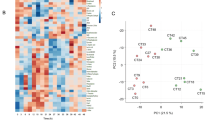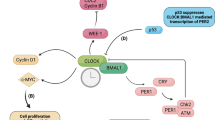Abstract
Circadian (∼24 hour) clocks are fundamentally important for coordinated physiology in organisms as diverse as cyanobacteria and humans. All current models of the molecular circadian clockwork in eukaryotic cells are based on transcription–translation feedback loops. Non-transcriptional mechanisms in the clockwork have been difficult to study in mammalian systems. We circumvented these problems by developing novel assays using human red blood cells, which have no nucleus (or DNA) and therefore cannot perform transcription. Our results show that transcription is not required for circadian oscillations in humans, and that non-transcriptional events seem to be sufficient to sustain cellular circadian rhythms. Using red blood cells, we found that peroxiredoxins, highly conserved antioxidant proteins, undergo ∼24-hour redox cycles, which persist for many days under constant conditions (that is, in the absence of external cues). Moreover, these rhythms are entrainable (that is, tunable by environmental stimuli) and temperature-compensated, both key features of circadian rhythms. We anticipate that our findings will facilitate more sophisticated cellular clock models, highlighting the interdependency of transcriptional and non-transcriptional oscillations in potentially all eukaryotic cells.
This is a preview of subscription content, access via your institution
Access options






Similar content being viewed by others
References
Dunlap, J. C. Molecular bases for circadian clocks. Cell 96, 271–290 (1999)
Takahashi, J. S., Hong, H. K., Ko, C. H. & McDearmon, E. L. The genetics of mammalian circadian order and disorder: implications for physiology and disease. Nature Rev. Genet. 9, 764–775 (2008)
Reddy, A. B. & O’Neill, J. S. Healthy clocks, healthy body, healthy mind. Trends Cell Biol. 20, 36–44 (2009)
Woelfle, M. A., Ouyang, Y., Phanvijhitsiri, K. & Johnson, C. H. The adaptive value of circadian clocks; an experimental assessment in cyanobacteria. Curr. Biol. 14, 1481–1486 (2004)
Dodd, A. N. et al. Plant circadian clocks increase photosynthesis, growth, survival, and competitive advantage. Science 309, 630–633 (2005)
Barger, L. K., Lockley, S. W., Rajaratnam, S. M. & Landrigan, C. P. Neurobehavioral, health, and safety consequences associated with shift work in safety-sensitive professions. Curr. Neurol. Neurosci. Rep. 9, 155–164 (2009)
Tomita, J., Nakajima, M., Kondo, T. & Iwasaki, H. No transcription-translation feedback in circadian rhythm of KaiC phosphorylation. Science 307, 251–254 (2005)
Lakin-Thomas, P. L. Transcriptional feedback oscillators: maybe, maybe not. J. Biol. Rhythms 21, 83–92 (2006)
Dodd, A. N. et al. The Arabidopsis circadian clock incorporates a cADPR-based feedback loop. Science 318, 1789–1792 (2007)
Johnson, C. H. et al. Circadian oscillations of cytosolic and chloroplastic free calcium in plants. Science 269, 1863–1865 (1995)
O’Neill, J. S., Maywood, E. S., Chesham, J. E., Takahashi, J. S. & Hastings, M. H. cAMP-dependent signaling as a core component of the mammalian circadian pacemaker. Science 320, 949–953 (2008)
Harrisingh, M. C., Wu, Y., Lnenicka, G. A. & Nitabach, M. N. Intracellular Ca2+ regulates free-running circadian clock oscillation in vivo . J. Neurosci. 27, 12489–12499 (2007)
Woolum, J. C. A re-examination of the role of the nucleus in generating the circadian rhythm in Acetabularia. J. Biol. Rhythms 6, 129–136 (1991)
Dibner, C. et al. Circadian gene expression is resilient to large fluctuations in overall transcription rates. EMBO J. 28, 123–134 (2009)
Hall, A., Karplus, P. A. & Poole, L. B. Typical 2-Cys peroxiredoxins–structures, mechanisms and functions. FEBS J. 276, 2469–2477 (2009)
Rhee, S. G., Jeong, W., Chang, T. S. & Woo, H. A. Sulfiredoxin, the cysteine sulfinic acid reductase specific to 2-Cys peroxiredoxin: its discovery, mechanism of action, and biological significance. Kidney. Int. 106 (Suppl.),. S3–S8 (2007)
Reddy, A. B. et al. Circadian orchestration of the hepatic proteome. Curr. Biol. 16, 1107–1115 (2006)
Hastings, M. H., Reddy, A. B. & Maywood, E. S. A clockwork web: circadian timing in brain and periphery, in health and disease. Nature Rev. Neurosci. 4, 649–661 (2003)
Hastings, M. H., Maywood, E. S. & Reddy, A. B. Two decades of circadian time. J. Neuroendocrinol. 20, 812–819 (2008)
Wright, K. P., Jr, Hull, J. T. & Czeisler, C. A. Relationship between alertness, performance, and body temperature in humans. Am. J. Physiol. Regul. Integr. Comp. Physiol. 283, R1370–R1377 (2002)
Barranco-Medina, S., Lazaro, J. J. & Dietz, K. J. The oligomeric conformation of peroxiredoxins links redox state to function. FEBS Lett. 583, 1809–1816 (2009)
Woo, H. A. et al. Reversible oxidation of the active site cysteine of peroxiredoxins to cysteine sulfinic acid. Immunoblot detection with antibodies specific for the hyperoxidized cysteine-containing sequence. J. Biol. Chem. 278, 47361–47364 (2003)
Cho, C. S. et al. Irreversible inactivation of glutathione peroxidase 1 and reversible inactivation of peroxiredoxin II by H2O2 in red blood cells. Antioxid. Redox Signal. 12, 1235–1246 (2010)
Griffon, N. et al. Tetramer-dimer equilibrium of oxyhemoglobin mutants determined from auto-oxidation rates. Protein Sci. 7, 673–680 (1998)
Hewitt, J. A., Kilmartin, J. V., Eyck, L. F. & Perutz, M. F. Noncooperativity of the dimer in the reaction of hemoglobin with oxygen (human-dissociation-equilibrium-sulfhydryl-absorption-x-ray analysis). Proc. Natl Acad. Sci. USA 69, 203–207 (1972)
Latenkov, V. P. Diurnal rhythm of acid-base equilibrium and blood gas composition [in Russian]. Biull. Eksp. Biol. Med. 101, 614–616 (1986)
Kennett, E. C. et al. Investigation of methaemoglobin reduction by extracellular NADH in mammalian erythrocytes. Int. J. Biochem. Cell Biol. 37, 1438–1445 (2005)
Ogo, S., Focesi, A., Jr, Cashon, R., Bonaventura, J. & Bonaventura, C. Interactions of nicotinamide adenine dinucleotides with varied states and forms of hemoglobin. J. Biol. Chem. 264, 11302–11306 (1989)
Jacobsen, M. P. & Winzor, D. J. Characterization of the interactions of NADH with the dimeric and tetrameric states of methaemoglobin. Biochim. Biophys. Acta 1246, 17–23 (1995)
Ghosh, A. K., Chance, B. & Pye, E. K. Metabolic coupling and synchronization of NADH oscillations in yeast cell populations. Arch. Biochem. Biophys. 145, 319–331 (1971)
Hess, B., Brand, K. & Pye, K. Continuous oscillations in a cell-free extract of S. carlsbergensis . Biochem. Biophys. Res. Commun. 23, 102–108 (1966)
Betz, A. & Chance, B. Phase relationship of glycolytic intermediates in yeast cells with oscillatory metabolic control. Arch. Biochem. Biophys. 109, 585–594 (1965)
Rutter, J., Reick, M. & McKnight, S. L. Metabolism and the control of circadian rhythms. Annu. Rev. Biochem. 71, 307–331 (2002)
Rutter, J., Reick, M., Wu, L. C. & McKnight, S. L. Regulation of clock and NPAS2 DNA binding by the redox state of NAD cofactors. Science 293, 510–514 (2001)
Nagoshi, E. et al. Circadian gene expression in individual fibroblasts: cell-autonomous and self-sustained oscillators pass time to daughter cells. Cell 119, 693–705 (2004)
Yagita, K., Tamanini, F., van der Horst, G. T. J. & Okamura, H. Molecular mechanisms of the biological clock in cultured fibroblasts. Science 292, 278–281 (2001)
van der Horst, G. T. J. et al. Mammalian Cry1 and Cry2 are essential for maintenance of circadian rhythms. Nature 398, 627–630 (1999)
Zhang, E. E. et al. A genome-wide RNAi screen for modifiers of the circadian clock in human cells. Cell 139, 199–210 (2009)
Qin, X., Byrne, M., Xu, Y., Mori, T. & Johnson, C. H. Coupling of a core post-translational pacemaker to a slave transcription/translation feedback loop in a circadian system. PLoS Biol. 8, e1000394 (2010)
Wood, Z. A., Schroder, E., Robin Harris, J. & Poole, L. B. Structure, mechanism and regulation of peroxiredoxins. Trends Biochem. Sci. 28, 32–40 (2003)
Eelderink-Chen, Z. et al. A circadian clock in Saccharomyces cerevisiae . Proc. Natl Acad. Sci. USA 107, 2043–2047 (2010)
Kippert, F., Saunders, D. S. & Blaxter, M. L. Caenorhabditis elegans has a circadian clock. Curr. Biol. 12, R47–R49 (2002)
O’Neill, J. S. et al. Circadian rhythms persist without transcription in a eukaryote. Nature doi:10.1038/nature09654 (this issue).
Corellou, F. et al. Clocks in the green lineage: comparative functional analysis of the circadian architecture of the picoeukaryote Ostreococcus . Plant Cell 21, 3436–3449 (2009)
Johnson, C. H., Mori, T. & Xu, Y. A cyanobacterial circadian clockwork. Curr. Biol. 18, R816–R825 (2008)
Reddy, A. B. et al. Circadian orchestration of the hepatic proteome. Curr. Biol. 16, 1107–1115 (2006)
Hu, T. et al. PEGylation of Val-1(α) destabilizes the tetrameric structure of hemoglobin. Biochemistry 48, 608–616 (2009)
Acknowledgements
This work was supported by the Wellcome Trust (083643/Z/07/Z), the MRC Centre for Obesity and Related metabolic Disorders (MRC CORD) and the NIHR Cambridge Biomedical Research Centre. We thank M. Jain and R. Edgar for discussions about the manuscript, A. Coles and J. Jones for providing access to samples, and G. van der Horst and F. Tamanini for providing access to Cry1 Cry2 knockout (and wild-type) mouse embryonic fibroblasts.
Author information
Authors and Affiliations
Contributions
A.B.R. and J.S.O’N. conceived, designed and performed the experiments, and wrote the manuscript.
Corresponding author
Ethics declarations
Competing interests
The authors declare no competing financial interests.
Supplementary information
Supplementary Information
The file contains Supplementary Tables 1-2, Supplementary Figures 1-9 with legends and additional references. (PDF 4348 kb)
Rights and permissions
About this article
Cite this article
O’Neill, J., Reddy, A. Circadian clocks in human red blood cells. Nature 469, 498–503 (2011). https://doi.org/10.1038/nature09702
Received:
Accepted:
Published:
Issue Date:
DOI: https://doi.org/10.1038/nature09702
This article is cited by
-
The role of insufficient sleep and circadian misalignment in obesity
Nature Reviews Endocrinology (2023)
-
Peroxiredoxins in erythrocytes: far beyond the antioxidant role
Journal of Molecular Medicine (2023)
-
Reduced nicotinamide adenine dinucleotide phosphate in redox balance and diseases: a friend or foe?
Acta Pharmacologica Sinica (2022)
-
A puromycin-dependent activity-based sensing probe for histochemical staining of hydrogen peroxide in cells and animal tissues
Nature Protocols (2022)
-
Circadian Regulation and Clock-Controlled Mechanisms of Glycerophospholipid Metabolism from Neuronal Cells and Tissues to Fibroblasts
Molecular Neurobiology (2022)



